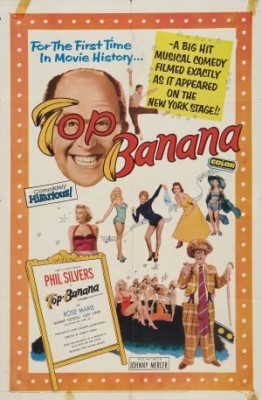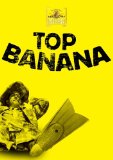| Reviews & Columns |
|
Reviews DVD TV on DVD Blu-ray 4K UHD International DVDs In Theaters Reviews by Studio Video Games Features Collector Series DVDs Easter Egg Database Interviews DVD Talk Radio Feature Articles Columns Anime Talk DVD Savant Horror DVDs The M.O.D. Squad Art House HD Talk Silent DVD
|
DVD Talk Forum |
|
|
| Resources |
|
DVD Price Search Customer Service #'s RCE Info Links |
|
Columns
|
|
|
Top Banana
By the end of their tour, in Los Angeles, the movie rights had been sold. To save money, it was decided that, rather than adapt Top Banana like other movie musicals, the film version would essentially document a complete performance of the stage show. Reusing the stage version's sets, costumes, and props, Top Banana unfolds entirely onstage, supposedly (but not really) in front of an occasionally seen, rarely heard from theater audience.
Further, the whole thing was filmed in 3-D, the idea being that moviegoers would vicariously experience a Broadway-style performance, from the vantage point of top dollar theater "seats."
For this and other reasons Top Banana has been a sought-after title for years. It was rarely shown on television or in repertory theaters, and it's one of just two 3-D films from the fifties that does not survive in 3-D, the other being Southwest Passage (also from United Artists). (Nevertheless, a 3-D trailer of Top Banana exists, and if you own a pair of Red-Green 3-D glasses you can watch it right now, on Mark Evanier's great News From Me site.)
But now, at last, there's an MGM "Limited Edition Collection" disc of Top Banana. It's missing about 15 minutes of footage and the print has several awkward splices, but the color is good and the image is sharp, despite some reports that all MGM currently has in its vault are 16mm elements. And, of course, it's not in 3-D.
The story is slight, with TV star Jerry Biffle (Silvers) battling his sponsor, Blendo Soap, while unwittingly getting tangled up in a love triangle with department store model Sally Peter (Judy Lynn), and a singer on Biffle's show, Cliff Lane (Danny Scholl). Jerry hatches a plan (well, actually he steals one of his minions' ideas), inviting the press to photograph Cliff's elopement as a headline-grabbing publicity ploy, all the while unaware the woman Cliff intends to marry is Jerry's girl.
Really, though, the plot of Top Banana is secondary to its fast-paced comedy, much of it a tribute to Burlesque and what even in the fifties were considered ancient jokes and comedy routines. In that sense Top Banana is reminiscent of Olson & Johnson's similarly nostalgic Hellzapoppin' and other stage shows featuring that team. The material may be old hat -"It was so hot, the Hoboken Ferry took off its slip!" - but audiences ate it up. Television, "Burlesque with an antenna," was in its infancy when the stage version opened in 1951, though it had grown by leaps and bounds even by early 1954 when the movie was released. Berle's longtime sponsor, Texaco, actually dropped him in 1953, and Berle's ratings went south.
Ironies abound: It was Silvers's Sgt. Bilko, airing simultaneously on another network, that finally killed Uncle Miltie's TV career. Also around that time Berle had incorporated behind-the-scenes segments on his show that were reminiscent of Top Banana's. Moreover, Berle himself reportedly invested in the Broadway Top Banana after learning it was based on him. Some of the inside jokes (a writer handing Jerry a slip of paper, "Here are your ad-libs!" / Rose Marie's line, "I can tell he's a writer by the lines on his face") are quite funny.
Phil Silvers had been kicking around for years, in Vaudeville, Burlesque, Broadway, and night clubs and then feature films beginning in 1940. However, rarely was there much hint of his Bilko-persona, at least in his pre-Bilko movies. But in Top Banana his Jerry Biffle is at least 80% Bilko, and it's the beginning of the crystallization of that persona. It's a different and even mildly unpleasant character, but most of the components and mannerisms are there. Moreover, playing Jerry's writers are actors Jack Albertson, Joey Faye, and, as Jerry's barber (who also provides an occasional joke for Jerry), Herbie Faye (no relation to Joey, apparently). Herbie Faye would soon become a regular on Bilko as Cpl. Fender, and later would appear on a number of episodes of The Dick Van Dyke Show, a series partly about television comedy writers. Joey Faye in this is reminiscent of Harvey Lembeck's Cpl. Barbella, on Bilko. Albertson plays a kind of human joke machine in Top Banana, a lot like Morey Amsterdam's Buddy Sorrell on The Dick Van Dyke Show. Rose Marie, who was Sally Rogers on The Dick Van Dyke Show, plays Sally Peters's roommate in Top Banana. Intrigued yet?
Those expecting a movie-movie will be sorely disappointed by the static approach taken by the filmmakers, who use mostly immobile wide and medium shots, in footage likely shot with two cameras (well, four since this was in 3-D) simultaneously to cover it all. On the other hand, if watched as if it were a theatrical performance, then Top Banana is pretty fun and very fascinating. The comedy, especially in terms of its timing, is exquisite, obviously having been perfected on Broadway and later on the road. Joey Faye, supposedly the creator of two iconic Burlesque routines, "Floogle Street" and "Slowly I Turned," is terrific throughout.
Nonetheless, the film suffers in unexpected ways. For instance, it may be the only movie in history that probably should have been filmed before a live audience, their laughter incorporated onto the soundtrack. There are occasional cutaways to an audience (probably stock footage) taking in the show, and they applaud at the end of Act One, but otherwise there's a deadly silence during all the comedy and no underscoring at all. Phil Silvers reportedly hated the film version and no wonder; he probably saw it in a half-filled theater or screening room, his best material playing to proverbial cricket chirping.
Doing it as a filmed performance presented other anomalies. The cast projects as if on stage, and the audio is weak in wide shots where microphones are obviously high in the rafters. Yet like a "real" movie musical the songs appear to have been pre-recorded, eliminating the immediacy of a live show.
The blocking of the actors is, well, stagy, and likely pretty darn close to the Broadway and roadshow versions. The reconstructed 3-D trailer hints at a much more visually interesting film, even though the 3-D gimmicks are few in number. (In one shot, Silvers tosses a couple of books at the 3-D cameras.) A very similar idea was proposed for the concurrent Cinerama process, a movie version of Porgy & Bess filmed in that multi-camera wonder. Though never made, the plan was to position the Cinerama cameras as if in a prime orchestra seat throughout. At least Top Banana moves in a little bit, with a greater variety of angles than the Cinerama likely would have offered, though all of the angles are still from an audience's perspective.
Unfortunately, Top Banana had a very limited release in 3-D if one at all. The 3-D craze of the 1950s technically lasted from late 1952 through early 1955 or so, but as far as the movie industry was concerned 3-D was dead in the water the minute 20th Century-Fox began demonstrating its CinemaScope widescreen process and making it available to other film companies. Top Banana appears to have opened only in 2-D, though there was talk of distributing it in 3-D later in its run.
Video & Audio
The correctly full-frame transfer of Top Banana generally looks fine, with rich, bright colors. If 16mm film was sourced, MGM did a good job because it's quite sharp overall. The missing footage appears to be the result of damage at the heads and tails of various reels, which exhibit more wear and on which reel change cues are sometimes visible. This version runs 83:47. The missing scenes create several disorienting jump cuts (particularly around the 35:00 mark), and there are a couple of other big splices with missing frames. However, all things considered we should be grateful it exists at all. The mono English audio (no subtitle options) is adequate on this region 1 disc. No Extra Features.
Parting Thoughts
Fans of musical theater, Phil Silvers, early television comedy and history, Sgt. Bilko, 3-D, and/or Burlesque will find much of value in Top Banana, a Recommended title.
Stuart Galbraith IV's latest audio commentary, for Media Blasters' Godzilla vs. Megalon (with Steve Ryfle), is on sale now.
|
| Popular Reviews |
| Sponsored Links |
|
|
| Sponsored Links |
|
|
| Release List | Reviews | Shop | Newsletter | Forum | DVD Giveaways | Blu-Ray | Advertise |
|
Copyright 2024 DVDTalk.com All Rights Reserved. Legal Info, Privacy Policy, Terms of Use,
Manage Preferences,
Your Privacy Choices | |||||||















